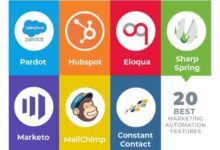What Is a Sales Pipeline And How Do You Build One?
Are you looking to boost your sales and grow your business? Then you need a sales pipeline. In simple terms, a sales pipeline is a visual representation of the various stages involved in converting a prospect into a paying customer. It provides valuable insights into your sales process, allowing you to track and manage your leads effectively. In this article, we will delve into the world of sales pipelines and explore how you can build one to drive your business forward.
Understanding the concept of a sales pipeline is crucial for any business owner or sales professional. It serves as a roadmap that guides your prospects through each step of the sales journey, from initial contact to closing the deal. By breaking down the process into distinct stages, you can identify bottlenecks, streamline your efforts, and increase your chances of success.
Setting up Your Sales Pipeline
Defining Your Target Audience
Before you can build an effective sales pipeline, you need to clearly define your target audience. Who are the individuals or businesses that are most likely to be interested in what you have to offer? By understanding your target audience’s needs, pain points, and buying behaviors, you can tailor your sales approach and messaging accordingly. Conduct market research, analyze customer data, and create buyer personas to gain a deep understanding of your ideal customers.
Setting Sales Goals
Once you have identified your target audience, the next step is to set clear and measurable sales goals. What do you want to achieve with your sales pipeline? Whether it’s increasing revenue, acquiring new customers, or expanding into new markets, your goals should be specific, realistic, and time-bound. Break down your overall sales goals into smaller, achievable targets for each stage of the pipeline.
Establishing Key Performance Indicators (KPIs)
Key Performance Indicators (KPIs) are essential metrics that help you track the progress and success of your sales pipeline. Identify the metrics that matter most to your business, such as conversion rates, average deal size, or sales cycle length. By regularly monitoring and analyzing your KPIs, you can identify areas for improvement and make data-driven decisions to optimize your sales process.
Prospecting and Lead Generation
Identifying High-Quality Leads
Effective prospecting starts with identifying high-quality leads that are most likely to convert into customers. Look for leads that align with your target audience profile and show genuine interest in your products or services. Utilize various lead generation methods, such as inbound marketing, content marketing, social media, and networking events, to attract potential customers.
Creating Compelling Lead Magnets
A lead magnet is something of value that you offer to your prospects in exchange for their contact information. It could be an e-book, a webinar, a free trial, or a discount. Create compelling lead magnets that resonate with your target audience and address their pain points. By providing value upfront, you can capture leads and start nurturing them through the sales pipeline.
Implementing a Lead Scoring System
Not all leads are created equal. Implementing a lead scoring system allows you to prioritize and focus your efforts on the leads with the highest potential to convert. Assign scores based on factors such as demographics, engagement level, and buying signals. This way, you can allocate your resources effectively and increase your chances of closing deals.
Qualifying Leads
Conducting Effective Qualification Calls
Qualification calls are an essential step in the sales pipeline, as they help you determine whether a lead is a good fit for your product or service. Prepare a list of qualifying questions to ask during these calls, focusing on understanding the prospect’s needs, budget, timeline, and decision-making process. By actively listening and asking the right questions, you can assess whether the lead meets your criteria and is worth pursuing.
Utilizing Lead Scoring and Segmentation
Building on the lead scoring system mentioned earlier, segment your leads based on their qualification levels and engagement. This allows you to tailor your sales approach and messaging to each segment. For example, highly qualified leads may require more personalized attention and a faster sales cycle, while lower-scoring leads may benefit from additional nurturing and education.
Collaborating with Marketing
Effective lead qualification requires close collaboration between sales and marketing teams. Marketing can provide valuable insights into lead behavior, engagement metrics, and content performance. By leveraging marketing data and aligning your efforts, you can ensure that only qualified leads enter your sales pipeline.
Nurturing Leads
Creating Personalized Email Campaigns
Email marketing is a powerful tool for nurturing leads and moving them through the sales pipeline. Create personalized email campaigns that deliver relevant and valuable content to your prospects at each stage. Segment your leads based on their interests, engagement, and position in the sales cycle to provide targeted messaging and increase conversion rates.
Providing Valuable Content
Content is key when it comes to nurturing leads. Create a content strategy that offers valuable resources, such as blog articles, whitepapers, videos, and case studies. Position yourself as a trusted advisor by addressing your prospects’ pain points and providing solutions. By consistently delivering high-quality content, you can build credibility and establish a strong relationship with your leads.
Utilizing Marketing Automation
Marketing automation tools can significantly enhance your lead nurturing efforts. Automate repetitive tasks, such as sending follow-up emails, scheduling reminders, and tracking engagement. By leveraging automation, you can streamline your processes, save time, and ensure that no leads fall through the cracks.
Presenting Your Solution
Understanding Your Prospect’s Pain Points
To effectively present your solution, you must first understand your prospect’s pain points. Research their challenges, goals, and current solutions. During sales conversations or presentations, emphasize how your product or service can alleviate their pain points and help them achieve their desired outcomes.
Customizing Presentations for Each Prospect
Every prospect is unique, and a one-size-fits-all presentation may not resonate with everyone. Customize your presentations to address each prospect’s specific needs and priorities. Highlight the features and benefits that are most relevant to them, and use case studies or testimonials to demonstrate how your solution has helped similar businesses or individuals.
Engaging in Two-Way Conversations
Presentations should not be one-sided monologues. Encourage two-way conversations with your prospects, allowing them to ask questions, share their concerns, and provide feedback. Actively listen to their responses and adjust your presentation accordingly. This creates a more engaging and collaborative environment, increasing the likelihood of a successful sale.
Handling Objections
Anticipating Common Objections
Objections are a natural part of the sales process, and successful sales professionals anticipate and prepare for them. Identify the common objections that prospects may have and develop persuasive responses. Address concerns about price, competition, implementation, or any other potential roadblocks.
Active Listening and Empathy
When faced with objections, it’s crucial to actively listen and empathize with your prospects. Understand the underlying reasons behind their objections and validate their concerns. By demonstrating empathy and understanding, you can build trust and credibility, increasing the chances of overcoming objections.
Providing Social Proof
Social proof, such as testimonials, case studies, or reviews, can be powerful tools in overcoming objections. Use real-life examples and success stories to show how your product or service has provided value to others. This reassures prospects and helps them overcome their hesitations.
Closing the Deal
Creating a Sense of Urgency
Creating a sense of urgency is crucial to closing deals. Offer limited-time promotions, discounts, or bonuses to incentivize prospects to take action. Emphasize the potential benefits they will miss out on if they delay their decision. However, ensure that the urgency is genuine and aligned with the prospect’s needs.
Asking for the Sale
It may seem obvious, but many sales professionals forget to ask for the sale. Clearly and confidently ask your prospects if they are ready to move forward. Provide any necessary guidance or assistance to facilitate the decision-making process. Sometimes a simple question can be the final push needed to close the deal.
Negotiating and Handling Objections
During the closing stage, negotiations may arise, and objections may resurface. Be prepared to navigate these challenges and find mutually beneficial solutions. Find common ground, explore alternative options, and maintain open lines of communication. The goal is to reach an agreement that satisfies both parties and leads to a successful close.
Post-Sale Follow-Up and Customer Retention
Sending Thank You Notes
After a sale is made, it’s important to show appreciation to your new customers. Send personalized thank you notes or emails to express gratitude for their business. This simple gesture goes a long way in building strong customer relationships.
Providing Onboarding and Support
Smooth onboarding and ongoing support are critical for customer retention. Ensure that your customers have a seamless transition intousing your product or service. Provide clear instructions, tutorials, and resources to help them get started and maximize the value they receive. Offer dedicated support channels, such as a customer service hotline or a helpdesk, to address any questions or concerns they may have throughout their journey.
Regularly Engaging with Customers
Stay connected with your customers even after the sale. Regularly engage with them through email newsletters, personalized offers, or social media interactions. Share relevant updates, industry insights, and exclusive content that adds value to their experience. By nurturing the relationship beyond the initial sale, you can foster customer loyalty and encourage repeat business.
Requesting Feedback and Reviews
Feedback and reviews from your customers are invaluable resources for improvement and growth. Encourage your customers to provide feedback on their experience with your product or service. This can be done through surveys, follow-up calls, or online review platforms. Actively address any concerns or issues raised, and use positive reviews to showcase your credibility and attract new customers.
Tracking and Analyzing Performance
Selecting Relevant Key Performance Indicators (KPIs)
When it comes to tracking your sales pipeline’s performance, it’s important to focus on the right Key Performance Indicators (KPIs). Choose metrics that align with your sales goals and provide meaningful insights into your pipeline’s effectiveness. Examples include conversion rates, average deal size, sales cycle length, or customer acquisition cost. Regularly monitor these KPIs to identify trends, patterns, and areas for improvement.
Utilizing Sales Analytics Tools
Sales analytics tools can help you gather and analyze data on your sales pipeline’s performance. These tools provide visualizations, reports, and dashboards that make it easier to interpret and derive insights from your sales data. Leverage these tools to gain a deeper understanding of your pipeline’s strengths and weaknesses, and make data-driven decisions to optimize your sales process.
Conducting Regular Sales Pipeline Reviews
Regularly reviewing your sales pipeline is essential for continuous improvement. Set aside time to analyze the performance of each stage, identify bottlenecks or areas of improvement, and adjust your strategies accordingly. Collaborate with your sales team to gather insights and share best practices. By conducting regular reviews, you can ensure that your sales pipeline remains dynamic and responsive to changing market conditions.
Optimizing Your Sales Pipeline
Automating Repetitive Tasks
Automation can significantly streamline your sales pipeline and increase efficiency. Identify repetitive tasks, such as data entry, follow-up emails, or scheduling appointments, and automate them using sales tools and software. This frees up time for your sales team to focus on building relationships and closing deals.
Implementing Technology and CRM Systems
Technology plays a crucial role in optimizing your sales pipeline. Implement a Customer Relationship Management (CRM) system to centralize customer data, track interactions, and manage leads effectively. Leverage sales enablement tools, such as email tracking, prospecting tools, or proposal generators, to enhance your sales team’s productivity and effectiveness.
Continuous Learning and Training
Invest in the continuous learning and development of your sales team. Provide ongoing training to keep them updated on industry trends, sales techniques, and product knowledge. Encourage knowledge sharing and collaboration within your team. By equipping your team with the necessary skills and knowledge, you can optimize your sales pipeline and drive better results.
Building a robust sales pipeline requires careful planning, execution, and continuous optimization. By following the steps outlined in this article, you can create a sales pipeline that effectively guides your prospects from initial contact to closing the deal. Remember, a well-structured and efficient sales pipeline allows you to nurture leads, address objections, and ultimately drive your business towards greater profitability.


